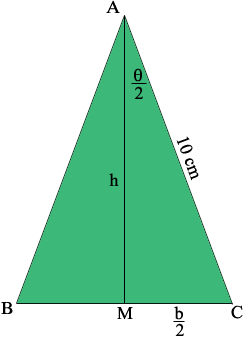| |||
| Math Central | Quandaries & Queries |
|
Question from sela, a student: An isosceles triangle has two equal sides of length 10 cm. Theta is the |
Sela,
I can get you started.

AM is perpendicular to BC and hence by the symmetry of this isosceles triangle |MC| = b/2 cm and the measure of angle CAM is θ/2 degrees. Thus cos(θ/2) = h/10 and sin(θ/2) = b/20. Hence the area of the triangle is
1/2 b × h = 100 sin(θ/2) cos(θ/2).
A trig identity will greatly simplify this expression. Do you know what it is?
Penny
 |
||
Math Central is supported by the University of Regina and The Pacific Institute for the Mathematical Sciences.